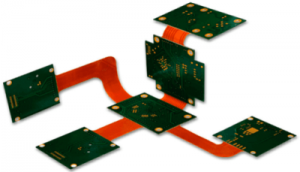Power of Rigid-Flex PCB Manufacturing
A rigid-flex circuit board combines the best features of both rigid and flexible printed circuit boards. The rigid section provides stability and structural strength, while the flexible portion makes it possible to fit the circuit into tight spaces. This hybrid design can help to enhance the performance, reliability, and cost of your product. Rigid-flex circuits are also ideal for high-shock and vibration applications.
The first step in creating a rigid-flex circuit is to choose the right PCB material. This is typically done through a thorough research process, where engineers or PCB designers evaluate the needs of the product and select the proper materials. Once the material is chosen, it’s then fabricated using high-tech equipment. This process includes etching the copper layers of the laminate. The copper layers may be etched with standard or advanced technology, including Microvias and blind/buried plated through holes.

Once the copper layers of the flex rigid pcb manufacturer are etched, it’s time to apply a cover lay. This layer is used to protect the circuit from harsh weather conditions, chemicals, and solvents. Cover lays can be made from a variety of materials, but the most common are polyimide and PTFE. This layer is imprinted with a screen-printing technique, and then laminated under specified limits of heat and pressure.
Unveiling the Power of Rigid-Flex PCB Manufacturing
Rigid-flex circuits are able to support more connections because they can be routed on both sides of the conductive copper layer. This enables them to have higher component density, which is especially useful in miniaturized electronic devices where space is limited. The hybrid design of a flex-rigid circuit board also provides mechanical stability that minimizes the risk of cracking or fatigue.
Another advantage of a rigid-flex circuit is that it allows for better design flexibility. This is because it has the ability to bend around corners or curved surfaces, which can be problematic for rigid-only PCBs. This feature can be particularly helpful in allowing designers to create more compact and sophisticated electronics that are more competitive in the marketplace.
Choosing a rigid-flex PCB manufacturer is an important decision because it will determine the quality of your final product. Look for manufacturers that have a strong track record of quality and delivery, and ask to see examples of their work. Then, choose a manufacturer that offers quick turnaround to ensure that your project is completed on schedule.
A quick turn manufacturer can also offer a number of benefits. These include reducing overall assembly costs and simplifying the wiring process. A quick turn manufacturer will have experienced technicians that can provide a quality product on short notice.
The best way to streamline your flex-rigid PCB design and fabrication process is to use software that’s easy to understand and provides an intuitive interface. Altium Designer is a great choice for this, because it gives you access to all of the CAD tools and automated drawing features that you need in one package. Start your free trial of Altium Designer today to see the power of this unified design environment for yourself.